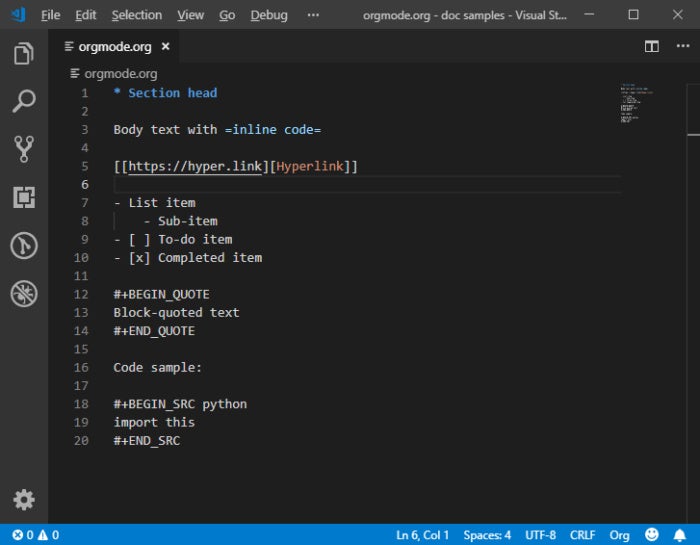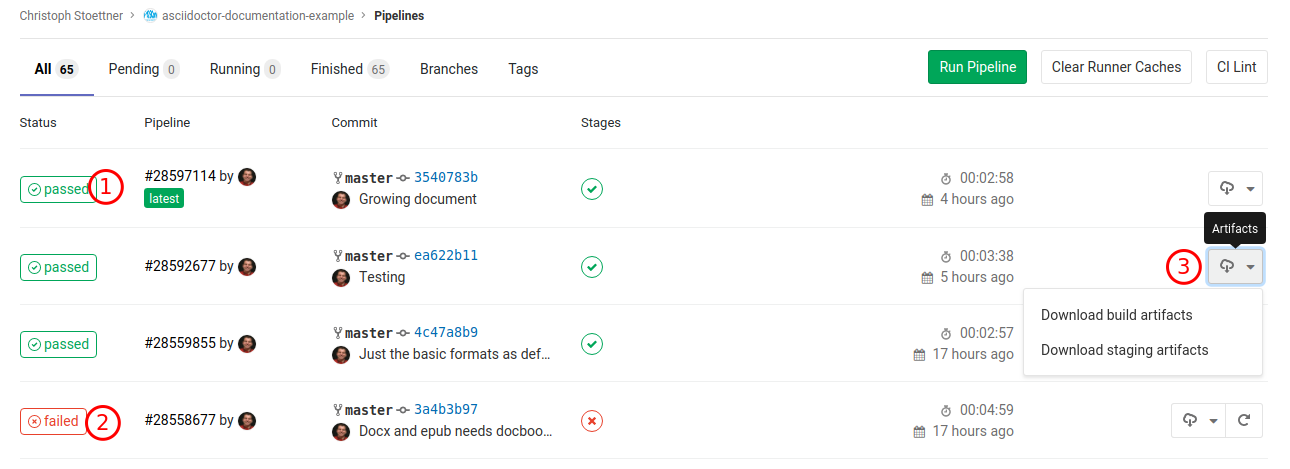Recently, I was writing a lot of Asciidoc / Asciidoctor for a document that I was working on for a customer at Red Hat.
Asciidoctor is a fantastic publishing tool – in fact, I used it to write my book, Camel Step-by-Step – but some of the syntax can be a bit hard to remember, especially when you’re using more advanced features like code snippets or admonitions (those “note”/”warning”/”important” type blocks!)

So I thought I’d make a cheatsheet to help me remember the key features that I use. You might not use all of these, or you might use some others that aren’t here. But I thought I would share the cheatsheet in case you find it useful too!
The Asciidoctor community offers a wide set of tools for the AsciiDoc format that can be installed additionally to Hugo. See the Asciidoctor docs for installation instructions. Make sure that also all optional extensions like asciidoctor-diagram or asciidoctor-html5s are installed if required. Short cheatsheet of asciidoc(tor) syntax and keywords - OneMoreGres/asciidoctor-cheatsheet.
Don't miss my next post!
Join my newsletter to enjoy my latest tutorials, thoughts and recommended links, no more than 2-3 times per month. Put your details in the form below to join today.
That’s what experience has conditioned us to believe.
But, we can’t just avoid it, especially in the tech industry.We must write.Even the most brilliant software is useless without good documentation.If the users fail, so does the project.
Unless your UI discoverability is really good, saying “the feature isn’t documented” is the same as saying “the product can’t do it.”
In other words,

Live and die by documentation.
Then why, oh why, do we make it more difficult by burying the content in XML schemas like DocBook, allowing complex word processors to distract us or wasting time battling with finicky WYSIWYG editors?

Imagine if writing documentation was as simple as writing an email.
That’s the idea behind lightweight markup languages such as AsciiDoc.They offer a plain-text syntax, embellished with subtle, yet intuitive markup, that’s designed for humans to read, write and edit in raw form.The natural feel of the syntax keeps you focused on the content.Best of all, the plain text can quickly and easily be translated into output formats such as HTML5 for presentation.
In this introduction to AsciiDoc, we’ll cover what it is, why it’s valuable and what sets it apart from alternatives such as Markdown.You’ll discover that the key to escaping the agony of writing documentation is dropping the angle brackets that are burying the knowledge you have to share.
To learn how to reduce the work of writing and publishing content—whether it’s notes, documentation, articles, books, web pages or good ol’-fashioned prose—and attain writing zen, or to simply set the ideas locked in your head free, read on.
What is AsciiDoc?
A mature[1], plain-text writing format for authoring notes, articles, documentation, books, ebooks, web pages, slide decks, blog posts, man pages and more.
A text processor and toolchain for translating AsciiDoc documents into various formats (called backends), including HTML, DocBook, PDF and ePub[2].
AsciiDoc belongs to the family of lightweight markup languages, the most renowned of which is Markdown.AsciiDoc stands out from this group because it supports all the structural elements necessary for drafting articles, technical manuals, books, presentations and prose.In fact, it’s capable of meeting even the most advanced publishing requirements and technical semantics.
Serving as testament of this fact, many O’Reilly authors including Matthew McCullough, Tim Berglund, Simon St.Laurent, Matt Neuburg and Ian Darwin have used AsciiDoc to write their books for that iconic technical library.
From the very beginning, AsciiDoc was designed to be a shorthand replacement for DocBook, one of the formats AsciiDoc can generate.AsciiDoc can also produce beautiful HTML5, PDFs, eBooks, man pages and even slide decks.It has you covered from first draft to publishing.
Asciidoc Cheat Sheet Deutsch
Now that we’ve established what AsciiDoc is, let’s consider why we need it.
Why AsciiDoc?
As humans, we have no difficulty talking or thinking.In fact, we’re fluent in it.It’s an activity that just happens whenever a thought comes to mind.
When it’s time to write our thoughts down, we struggle to find the words—or, at least, how to arrange and organize them.That damn inner critic disrupts the stream of consciousness we coast on while talking or thinking.
It’s reasonable to conclude that writing is just hard.
On writing: e-mail vs documents
Writing e-mail is easy.We do it all the time.Every day, we respond to dozens of e-mail and social media messages.That involves communication through writing.That’s right, writing!
Yet, amid the flurry of typing that occurs when we respond to an e-mail, we hardly even realize we’re doing it…and fluently!
Most people are OK with writing e-mails.They don’t consider this writing.There’s no writer’s block.Someone asks you a question, you [press] reply and type away.
So why do we struggle to write documents?
The main reason we struggle is because we don’t write documents the same way we write e-mail.Instead, we allow ourselves to get distracted by complex word processors, bury the content in XML schemas like DocBook, or battle with finicky WYSIWYG editors.How did we get ourselves into this mess?

Word processors, the real writer’s block
When you’re in the writing (i.e., typing) phase, you want the words to flow onto the screen with minimal distractions and interruptions.Flow, not just time, is essential.
Most word processors excel at distracting you from writing.The result: you write less (ironic, huh?).
In a word processor, before you can type the first word on a blank white screen, you’re forced to think about what font family you want, what font size you want, what lines spacing you want and so on.Once you do get going, auto-correct, spelling and grammar suggestions entice you to backtrack and lose your next thought.“Smart” quotes and auto-linking messes with the text as fast as you can enter it.If you paste text, it likely gets added to the document with a different font family, size and even color.
Let’s not even talk about inserting source code.The designers of word processors clearly did not.
After burning time fighting with its interface, you rightfully conclude that the word processor is trying to sabotage your writing process.
Asciidoc Cheatsheet
But how?
Use what you know
What if you could write documentation like you write e-mail?
Imagine being able to forget about layout, typesetting, styling (and even some semantics) and just write.That’s the idea behind lightweight markup languages such as Markdown and AsciiDoc.
Here’s how John Gruber introduced Markdown (in March 2004):
The overriding design goal for Markdown’s formatting syntax is to make it as readable as possible.
A Markdown-formatted document should be publishable as-is, as plain text, without looking like it’s been marked up with tags or formatting instructions.
The single biggest source of inspiration for Markdown’s syntax is the format of plain text e-mail.
Similarly, here’s how Stuart Rackham introduced AsciiDoc (2 years earlier):
You write an AsciiDoc document the same way you would write a normal text document.There are no markup tags or weird format notations.AsciiDoc files are designed to be viewed, edited and printed directly or translated to other presentation formats.
These languages are designed to enable humans to write documents, and for other humans to be able to read them, as is, in raw form.
It’s a plain text syntax…I know this!
Compare that to the same document written in DocBook:
Yikes!
While DocBook (and HTML) may not be complex, they fail the readability test.
DocBook is nice, but (like XML) it is not meant for editing nor for merging changes (by humans).Using AsciiDoc (which translates to DocBook perfectly) is a much easier way of developing.
AsciiDoc gets us back to what’s important: writing.You can drop those angle brackets, but you don’t have to drop the semantics.And it’s a syntax a human can actually edit, efficiently.
Use AsciiDoc for document markup.Really.It’s actually readable by humans, easier to parse and way more flexible than XML.
Here’s the really great thing about AsciiDoc.Worse case scenario, you convert it to DocBook as a common exchange format.DocBook is the “no lock-in” exit path for AsciiDoc.You decide AsciiDoc doesn’t work out, you can bail on it without losing a word.No need to invent another format.That’s why so many people are going all in on it.
Who’s using AsciiDoc?
AsciiDoc is not as widely adopted as Markdown, but it’s used in some pretty serious places. Here are a few notable examples:
O’Reilly and MakerPress
GitHub supports AsciiDoc syntax in repositories, wikis and gists (powered by Asciidoctor)
NFJS, the Magazine is produced from articles written in AsciiDoc
Context and Dependency Injection for the Java EE Platform (CDI)
Specification (AsciiDoc source)
Website (AsciiDoc source)
Golo Programming Language Guide (AsciiDoc source)
Neo4j graph database project (AsciiDoc source)
Phusion Passenger Users Guides (AsciiDoc source)
Git user manual (AsciiDoc source)
Enterprise Web Development: From Desktop to Mobile (AsciiDoc source)
Bintray REST API and User Guide
These examples are more than just testimonials.They should give you ideas about how to be successful with AsciiDoc for your own project.
The zen of writing AsciiDoc
AsciiDoc is about being able to focus on expressing your ideas, writing with ease and passing on knowledge without the distraction of complex applications or angle brackets.In other words, it’s about discovering writing zen.
It’s readable
It’s concise
It’s comprehensive
It’s extensible
It produces beautiful output (HTML, DocBook, PDF, ePub and more)
AsciiDoc is easy to write and easy to read (in raw form).It’s also easy to proof and edit.After all, it’s plain text, just like that familiar e-mail.
The AsciiDoc syntax is intuitive because it recognizes time-tested, plain text conventions for marking up or structuring the text.The punctuation was carefully chosen to look like what it means.A user unfamiliar with AsciiDoc can figure out the structure and semantics (i.e., what you mean) just by looking at it.Best of all, it only requires a text editor to read or write.
AsciiDoc allows you to focus on the actual writing and only worry about tweaking the output when you are ready to convert the document.The plain-text of an AsciiDoc document is easily converted into a variety of output formats, beautifully formatted, without having to rewrite the content.
Copy text from an e-mail into a document and see how quickly you can turn it into documentation.Almost immediately, you’ll find your writing zen and enjoy the rewarding experience of sharing knowledge.
Asciidoc Cheat Sheet Note
Next steps
Ascii Docs
With an understanding of what AsciiDoc is and why it’s so desperately needed, you’re encouraged to delve into the AsciiDoc syntax covered in the AsciiDoc Writer’s Guide.If you’re just looking for a cheat sheet, check out the AsciiDoc Quick Reference.Hopefully you’ll agree the syntax just makes sense.
Asciidoc Example
